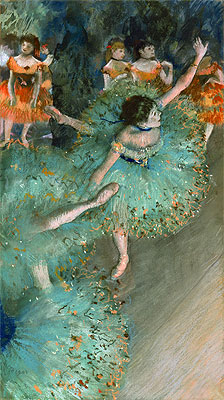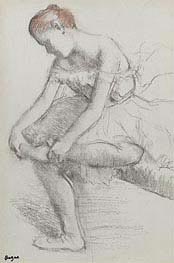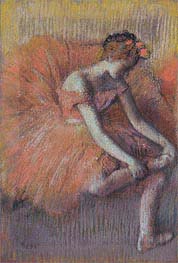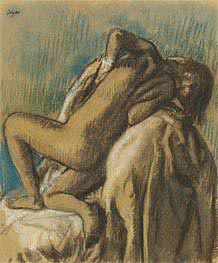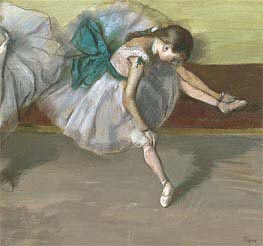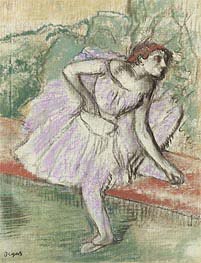Swaying Dancer (Dancer in Green), c.1877/79 by Hilaire Germain Edgar Degas
Paper Art Print - 11878-DEE
Location: Thyssen-Bornemisza Museum, Madrid, SpainOriginal Size: 64 x 36 cm
Giclée Paper Print | $52.4 USD
Your Selection
Customize Your Print
By using the red up or down arrows, you have the option to proportionally increase or decrease the printed area in inches as per your preference.
*Max printing size: 25.2 x 14.1 in
*Max framing size: Long side up to 28"
"Swaying Dancer (Dancer in Green)" will be custom-printed for your order using the latest giclée printing technology. This technique ensures that the Paper Art Print captures an exceptional level of detail, showcasing vibrant and vivid colors with remarkable clarity.
Our choice of a non-woven art paper guarantees premium quality. This paper is free of optical brighteners and has a delicate watercolor texture that adds an artistic flair to art reproductions. Combined with a matte coating, it creates stunning art prints with vibrant colors, rich blacks, and exceptional detail reproduction.
Additional blank areas are included on all sides of the printed area, providing versatility for various purposes.
Our printing process utilizes cutting-edge technology and employs the Giclée printmaking method, ensuring exceptional quality. The colors undergo independent verification, guaranteeing a lifespan of over 100 years.
Please note that there are postal restrictions limiting the size of framed prints to a maximum of 28 inches along the longest side of the painting. If you desire a larger art print, we recommend utilizing the services of your local framing studio.
*It is important to mention that the framing option is unavailable for certain paintings, such as those with oval or round shapes.
If you select a frameless art print of "Swaying Dancer (Dancer in Green)" by Edgar Degas, it will be prepared for shipment within 48 hours. However, if you prefer a framed artwork, the printing and framing process will typically require approximately 7-8 days before it is ready to be shipped.
We provide complimentary delivery for up to two unframed (rolled-up) art prints in a single order. Our standard delivery is free and typically takes 10-14 working days to arrive.
For faster shipping, we also offer express DHL shipping, which usually takes 2-4 working days. The cost of express shipping is determined by the weight and volume of the shipment, as well as the delivery destination.
Once you have added the paintings to your shopping cart, you can use the "Shipping estimates" tool to obtain information about available transport services and their respective prices.
All unframed art prints are delivered rolled up in secure postal tubes, ensuring their protection during transportation. Framed art prints, on the other hand, are shipped in cardboard packaging with additional corner protectors for added safety.
Painting Information
Swaying Dancer (Dancer in Green) presents a precisely observed view of ballerinas in mid-performance, captured at an oblique angle that places the viewer high above the stage. The central figure, shown in a full-length turn, anchors the composition with an outstretched arm and raised leg. Her vivid green tutu and lithe form dominate the foreground, while the surrounding dancers - partially cropped and dressed in contrasting orange - hint at a more expansive scene beyond the edge of the canvas. This truncation, derived from photographic and Japanese-print influences, underscores the painting’s sense of spontaneity and modernity.
The color palette favors vibrant green for the main performer, offset by flecks of orange on the other costumes. The background, a shadowy suggestion of set pieces and foliage, dissolves into loose strokes that shift focus back to the dancers themselves. These bold chromatic choices underscore the interplay of cool and warm tones, guiding the eye in rhythmic alternation across the figures. Rather than relying on stark contrast, the artist creates unity with balanced harmonies, deftly capturing the theatrical lighting that both illuminates the dancers and leaves their environs in partial obscurity.
The technique employed reveals a mastery of pastel. Rapid strokes describe tulle, ribbons, and limbs in motion, while smudged areas convey a fleeting, dreamlike quality befitting a performance captured at its peak. Layering pigments allows subtle modulation of tone, especially in the airy tutus, which appear both diaphanous and texturally rich. This variety of mark-making reflects an intention to record the dancers’ swift passages without sacrificing detail.
Compositionally, the off-centered arrangement places the focal figure near the vertical axis of the paper but shifted to one side, creating a diagonal sweep that leads our gaze from her extended limb toward the group in the rear. Such an asymmetrical layout imbues the painting with movement, reflecting contemporary interests in framing and cropping. By positioning the viewer as an unseen spectator in an opera box, the artist evokes the bustle and immediacy of the performance, a contrast to earlier traditions that favored static, centered subjects.
In the broader context of late 19th-century Paris, the fascination with modern leisure activities and the newly opened opera house finds clear expression here. The dancers’ poised yet hurried maneuvers embody the Impressionist preoccupation with capturing fleeting moments of daily life. Through dynamic composition, nuanced color relationships, and expert pastel handling, the painting remains a remarkable testament to the era’s aesthetic and cultural shifts.
